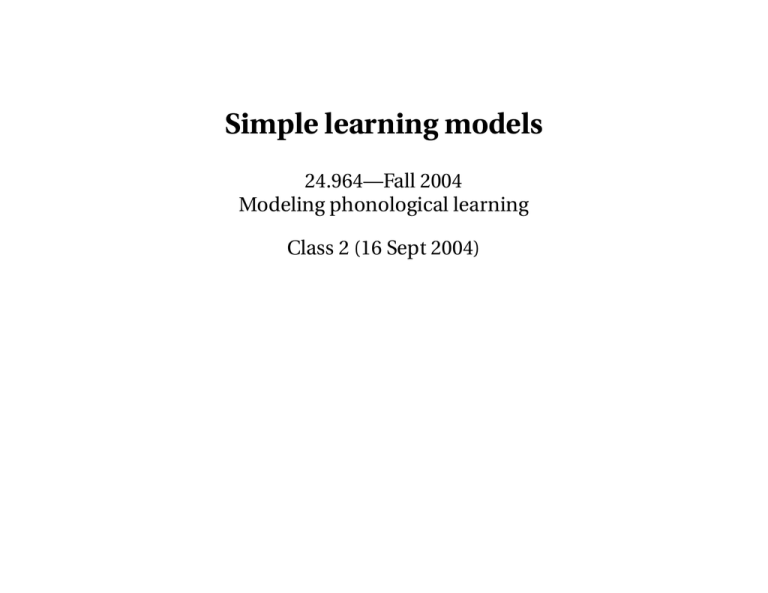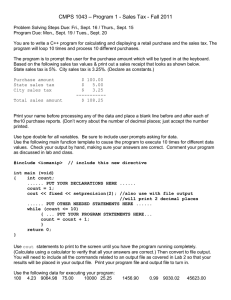Document 13555683
advertisement

Simple learning models
24.964—Fall 2004
Modeling phonological learning
Class 2 (16 Sept 2004)
24.964—Class 2
16 Sept, 2004
Learning (from the phonology perspective)
Learner hears (existing) words, and learns them Learner
notices certain patterns are (or are not) present Constructs
grammar to capture those patterns Uses grammar in
production of words (both known and new)
24.964—Class 2
16 Sept, 2004
Learning (from the AI perspective)
LEARNING AGENT
Learning
component
Evaluation
component
ENVIRONMENT
modifies
Performance
component
sensors
actuators
input
output
24.964—Class 2
16 Sept, 2004
Learning phonology
LEARNING AGENT
Learning
component
Evaluation
component
ENVIRONMENT
modifies
Performance
lexicon,
component
grammar
sensors
perceptual
system
input
other people
saying stuff
actuators
output
phonetic
implementation
24.964—Class 2
16 Sept, 2004
Learning phonology
Pieces of a learning model:
• Way to receive input
• Way of representing that input
• Way to compare new input with what is already known
• Way to modify what is known (if necessary)
• Way to use knowledge to produce new outputs
24.964—Class 2
16 Sept, 2004
Constructing a learning model
A performance component that we saw last week
$input_file = "Japanese­ToConvert.txt";
open (INFILE, $input_file) or die "Warning! Can’t open input file: $!\n";
while ($line = <INFILE>) {
# Crucial rule ordering: this needs to go first
$line =~ s/hu/fu/g;
# The major difference is use of <y> after t,s,z
$line =~ s/ty/ch/g;
$line =~ s/sy/sh/g;
$line =~ s/zy/j/g;
# Also, palatalization before i
$line =~ s/ti/chi/g;
$line =~ s/si/shi/g;
$line =~ s/zi/ji/g;
# And assibilation of t before u
$line =~ s/tu/tsu/g;
print "$line";
}
24.964—Class 2
16 Sept, 2004
Constructing a learning model
Some easy steps
• Reading in the input
• Doing something to it, and outputting it
• Compare to a “given” answer, to see if the model is right
(See checkmath.pl from last week for an example of
comparing calculated and given answers; also hepburn2.pl)
24.964—Class 2
16 Sept, 2004
Terminology
Supervised learning
• Learner is given stimuli (inputs) and also answers (outputs)
• Comparing the input and the output lets the learner see
what it needs to learn
• Task is to learn a function converting inputs to their
corresponding outputs
24.964—Class 2
16 Sept, 2004
Terminology
Unsupervised learning
• Learner receives only input, but no output values
•
Model is not told “what to do”
• It looks at the data and tries to find patterns; figure out
what types of inputs are likely to occur
24.964—Class 2
16 Sept, 2004
Constructing a learning model
We will be looking (primarily) at supervised models here
• In this case, the model is given both the input (Monbushô)
and output (Hepburn) forms
• Feedback/evaluation: the model produces an output and
checks its own answer, to determine whether more learning
must occur
24.964—Class 2
16 Sept, 2004
The importance of feedback
Error­driven learning
• Error rate = (number of errors / number of cases)
◦ (1 − error rate) = accuracy, or coverage of the hypothesis
24.964—Class 2
16 Sept, 2004
The importance of feedback
Distinguishing between different types of errors
Prediction
Positive
Prediction
Negative
Class Positive
True
Pos
False
Neg
Class Negative
False
Pos
True
Neg
• Correct applications: true positive, true negative
• Misclassifications: false positive, false negative
(See hepburn3.pl; this program attempts to calculate false
positives and false negatives, but can’t quite do it
accurately—why not?)
24.964—Class 2
16 Sept, 2004
Constructing a learning model
The interesting part: actually learning
• We need to be able to modify the performance component
somehow
• In the program hepburn3.pl, that would require modifying
the replacement statements themselves (that is, rewriting
the program)
• If we want to modify the statements of the grammar, we
must store them in variables somehow
24.964—Class 2
16 Sept, 2004
Constructing a learning model
Some programs
• hepburn4.pl: storing rules in an array of arrays
• hepburn5.pl: reading rules from a file, and “pushing”
them onto the array of rules
• hepburn6.pl: same, but reads in forms and answers first
and stores then, and then runs through them to derive
outputs for them
24.964—Class 2
16 Sept, 2004
Constructing a learning model
Modifying the grammar itself
• What are the two aspects of the grammar that must be
right in order to get the right answer??
24.964—Class 2
16 Sept, 2004
Constructing a learning model
Starting in the middle of things:
• Let’s assume some rules have been learned, and the goal
is to get them in the right order
• In other words, already starting with a hypothesis about
the function
24.964—Class 2
16 Sept, 2004
Constructing a learning model
More terminology:
• Hypothesis space: set of all possible functions the learner
could (in principle) discover to explain the data
• Consistent hypotheses: set of functions that correctly
explain the data
24.964—Class 2
16 Sept, 2004
Constructing a learning model
Two possible tasks:
• Find a hypothesis that is consistent with the data
• Learn what characterizes the set of consistent hypotheses
24.964—Class 2
16 Sept, 2004
Constructing a learning model
What is the hypothesis space for grammars of ordered
rules? (assuming, for the moment, that the rules
themselves are fixed)
• What is the set of possible hypotheses?
• How big is it
24.964—Class 2
16 Sept, 2004
Comparison: decision lists
A similar problem with an even larger search space
• Decision lists: predicting an outcome based on a series of
yes/no or forced choice answers
• Demo:
http://www.cs.ubc.ca/labs/lci/CIspace/Version3/dTree/index.
html
24.964—Class 2
16 Sept, 2004
Comparison: decision lists
“All electronics” data set
Age
≤30
≤30
30­40
>40
>40
>40
30­40
≤30
≤30
>40
≤30
30­40
30­40
>40
Income
high
high
high
med
low
low
low
med
low
med
med
med
high
med
Student?
no
no
no
no
yes
yes
yes
no
yes
yes
yes
no
yes
no
Credit
fair
excellent
fair
fair
fair
excellent
excellent
fair
excellent
fair
excellent
excellent
fair
excellent
Buys
no
no
yes
yes
yes
no
yes
no
yes
yes
yes
yes
yes
no
24.964—Class 2
16 Sept, 2004
Comparison: decision lists
Predictive power of factors:
Factor
Level
How many buy
≤30
2/5
Age
30­40
4/4
>40
3/5
low
3/4
Income med
4/6
high
2/4
yes
6/7
Student
no
3/7
fair
5/7
Credit
excellent
4/7
24.964—Class 2
16 Sept, 2004
Comparison: decision lists
Age?
≤30
???
30-40
Buys
>40
???
24.964—Class 2
16 Sept, 2004
Comparison: decision lists
Step 2
Age
≤30
≤30
30­40
>40
>40
>40
30­40
≤30
≤30
>40
≤30
30­40
30­40
>40
Income
high
high
high
med
low
low
low
med
low
med
med
med
high
med
Student?
no
no
no
no
yes
yes
yes
no
yes
yes
yes
no
yes
no
Credit
fair
excellent
fair
fair
fair
excellent
excellent
fair
excellent
fair
excellent
excellent
fair
excellent
Buys
no
no
yes
yes
yes
no
yes
no
yes
yes
yes
yes
yes
no
Explained
�
�
�
�
24.964—Class 2
16 Sept, 2004
Comparison: decision lists
Step 2
Age
≤30
≤30
30­40
>40
>40
>40
Income
high
high
Student?
no
no
Credit
fair
excellent
Buys
no
no
med
low
low
no
yes
yes
fair
fair
excellent
yes
yes
no
≤30
≤30
>40
≤30
med
low
med
med
no
yes
yes
yes
fair
excellent
fair
excellent
no
yes
yes
yes
>40
med
no
excellent
no
Explained
24.964—Class 2
16 Sept, 2004
Comparison: decision lists
Predictive power among remaining cases:
Factor
Income
Student
Credit
Level
low
med
high
yes
no
fair
excellent
≤30 buy
1/1
1/2
0/2
2/2
0/3
2/3
0/2
>40 buy
1/2
2/3
0/0
2/3
1/2
3/3
0/2
24.964—Class 2
16 Sept, 2004
Comparison: decision lists
Age?
≤30
30-40
Student?
>40
YES
yes
no
YES
NO
Credit?
fair
YES
excellent
NO
24.964—Class 2
16 Sept, 2004
Back to ordered rules
Why would this same strategy not work for ordered rules?
24.964—Class 2
16 Sept, 2004
Learning rule orderings
• Naive first approach: hepburn7.pl (why does this work
relatively well?)
• Comparison: italian.pl
24.964—Class 2
16 Sept, 2004
Reducing the hypothesis space for ordered rules
What are some principles that would reduce the number of
possibilities to explore for ordered rules?
24.964—Class 2
16 Sept, 2004
The Elsewhere condition (Kiparsky 1982)
Rules A, B in the same component apply disjunctively to a
form φ if and only if
1. The structural description of A (the special rule) includes
the structural description of B (the general rule)
2. The result of applying A to φ is distinct from applying B to
φ In that case, A is applied first, and if it takes effect, then
B is not applied.
24.964—Class 2
16 Sept, 2004
Does the Elsewhere condition reduce search
space?
An attempt to test this (imperfectly): italian2.pl
24.964—Class 2
16 Sept, 2004
For next week
• Assignment 2: two parts (see handout)
• Readings: (on course website)
◦ Hutchinson, chapter 1
◦ Weiss & Kulikowski, chapter 2
� Focus on the general concepts and techniques presented
here (don’t worry about all the mathematical details)






